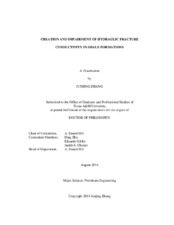Creation and Impairment of Hydraulic Fracture Conductivity in Shale Formations
Abstract
Multi-stage hydraulic fracturing is the key to the success of many shale gas and shale oil reservoirs. The main objectives of hydraulic fracturing in shale are to create artificial fracture networks that are conductive for oil and gas flow and extensive into the reservoir for high and long-lasting production, while economical to keep the well commercial.
Due to the variation in shale mineralogical and mechanical properties, mechanisms of fracture conductivity creation in shale formations are complicated. Standard fracture conductivity measurement procedures were developed for high concentration propped fractures and need to be modified to measure the conductivity of unpropped fractures and the low concentration proppant packs. Water-based fracturing fluids can interact with the clay minerals in shale and eventually impact shale fracture conductivity. All these challenges require more studies to elevate the understanding of shale fracture conductivity creation and impairment.
The aims of this work are to design an experimental framework to measure fracture conductivity created by different mechanisms, to develop a correlation calibrated by the experimental data to predict shale fracture conductivity, and to investigate the mechanisms of conductivity damage by water. We first present the laboratory procedures and experimental design that can accurately measure fracture conductivity of shale fractures. Then, a program is developed to calculate conductivity considering the physical processes that dictate propped fracture conductivity as observed in the experiments. After the undamaged shale fracture conductivity is measured by dry nitrogen, water with similar flowback water compositions is flowed to simulate the damage process followed by the second gas flow to measure the recovered fracture conductivity after the water damage.
From this study, we find that the unpropped shale fractures are conductive up to certain closure stress by a variety of mechanisms. The correlation we develop can capture the physical processes in the shale fracture and can reasonably predict propped fracture conductivity. Shale fracture surface softening is identified as the dominant cause for the significant conductivity reduction after water flow.
The systematic study on realistic shale fracture conductivity is the foundation of well performance analysis and production history matching. The investigation on water damage can better guide the fracturing design in shale reservoirs.
Subject
Fracture conductivityBarnett shalel Eagle Ford shalel Fayetteville shale
water-shale interaction
conductivity damage
Citation
Zhang, Junjing (2014). Creation and Impairment of Hydraulic Fracture Conductivity in Shale Formations. Doctoral dissertation, Texas A & M University. Available electronically from https : / /hdl .handle .net /1969 .1 /153365.


